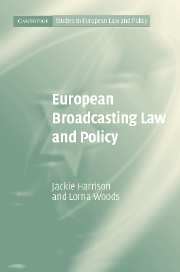Book contents
- Frontmatter
- Contents
- Series Editors' Preface
- Preface
- Case list
- PART I
- PART II
- 6 Access
- 7 Media ownership: impact on access and content
- 8 Jurisdiction, forum shopping and the ‘race to the bottom’
- 9 Advertising placement and frequency: balancing the needs of viewers and commercial interests
- 10 Negative content regulation
- 11 Positive content regulation: quotas
- 12 Privatisation of sport and listed events
- 13 State aid: constraints on public service broadcasting
- PART III
- Appendix
- Bibliography
- Index
9 - Advertising placement and frequency: balancing the needs of viewers and commercial interests
Published online by Cambridge University Press: 29 July 2009
- Frontmatter
- Contents
- Series Editors' Preface
- Preface
- Case list
- PART I
- PART II
- 6 Access
- 7 Media ownership: impact on access and content
- 8 Jurisdiction, forum shopping and the ‘race to the bottom’
- 9 Advertising placement and frequency: balancing the needs of viewers and commercial interests
- 10 Negative content regulation
- 11 Positive content regulation: quotas
- 12 Privatisation of sport and listed events
- 13 State aid: constraints on public service broadcasting
- PART III
- Appendix
- Bibliography
- Index
Summary
Introduction
Advertising, and its proper control, are and have been contentious areas. The cross-border character of television reach, a consequence of the development of satellite technology, caused further regulatory concerns regarding jurisdiction and the control of advertising. This was particularly problematic in the light of different national approaches to the regulation of advertising. The Television without Frontiers Directive (TWDF) contains specific provisions to deal with advertising, so as to create Union minimum standards, but it is questionable to what extent these rules protect all viewers, whether citizen or consumer.
As we argued in chapter 1, within both the commercial and public service domains, viewers have different capacities to select, engage with or opt out of content, including advertising. With the changing broadcasting environment, discussed in chapter 3, broadcasters and advertisers are adopting new advertising techniques the better to target audiences. Some of these techniques make it more difficult to separate what we shall refer to as editorial and commercial content. Editorial content refers to the informational or entertainment narrative structure, order or plot of programmes. Commercial content includes all forms of advertising, ranging from conventional adverts, interactive adverts, sponsorship and product placement. The assumptions underlying the TWFD suggest that, in general, consumers are served by attempts to limit market distortions and unfair competition, while citizens are served by seeing advertising superintended in ways which (should) preserve editorial freedom and independence.
- Type
- Chapter
- Information
- European Broadcasting Law and Policy , pp. 194 - 217Publisher: Cambridge University PressPrint publication year: 2007



